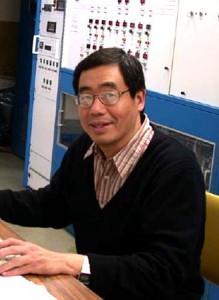 Dr. Fow-Sen Choa uses a Chemical Vapor Desposition System to grow semiconductors that are used for chemical detection and breath analysis using photo-acoustic (PA) effects.
Dr. Fow-Sen Choa uses a Chemical Vapor Desposition System to grow semiconductors that are used for chemical detection and breath analysis using photo-acoustic (PA) effects.
In his opto-electronics and MOCVD lab, Dr. Fow-Sen Choa, professor, uses a Chemical Vapor Deposition System to grow semiconductors, which include semiconductor lasers, semiconductor detectors, semiconductor optical amplifiers, modulators, and optical switches. A member of MIRTHE (Mid-Infrared Technologies for Health and the Environment), whose mission is to conduct research with postdocs and graduate students, while engaging undergraduate students, high school teachers and students in science and engineering projects as a way to encourage them to pursue careers in the field, Dr. Choa is responsible for providing MIRTHE with mid-IR materials, lasers, detectors and subsystems.
The semiconductors grown by Dr. Choa in his lab can also be applied for chemical detection and breath analysis using photo-acoustic (PA) effects. “When the wavelength of the photon matches with molecules’ vibrational transition, light can generate acoustic signals through thermal expansion,” he explains. “Using the PA effect, people have demonstrated parts per billion chemical detection sensitivities. Using the chemical sensing capability we can monitor contamination in our environment and the chemical content of our breath as precursors of our health conditions.” Dr. Choa has more than 250 referred publications in his research areas and is a fellow of the Optical Society of America.
In addition to his own research, Dr. Fow-Sen Choa has been working with undergrad students at UMBC on projects dealing with flying robots, Fourier analysis of music instrument, x-ray scan of superlattice crystal growths, and brainwave measurement and analysis. Dr. Choa is currently the advisor of UMBC’s IEEE student branch. This year, three Computer Engineering students—Sheriff Jolaoso, Ugonna ohiri, and Linh Pham—received Undergraduate Research Awards as a result of research carried out within Dr. Choa’s group. Their research is focused on acoustic beam forming for PA sensing, real time brainwave measurement systems, and optical neuron excitation systems. The next step of these projects is to develop standoff explosive detection systems and prosthetic arms capable of feeling. Dr. Choa and his students are looking into utilizing mid-infrared technologies to accomplish this goal. He is also collaborating with faculty at CBE department, UMB, and researchers NIH on researches dealing with brain circuitry.
“Undergraduate students are full of imagination,” says Dr. Choa, adding that working with undergraduate students is always exciting and fun. “Now we have many crazy ideas ranging from brain circuits, future computers, and bio-electronic robotics, besides prosthetic applications,” he says. In fact, the students’ success has prompted the implementation a new Computer Engineering laboratory course dealing with Bio Electronics and Bio Photonics, which may start in 2012.